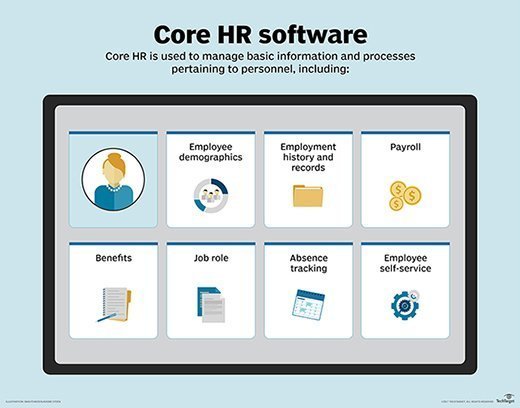What is core HR (core human resources)?
Core HR (core human resources) is an umbrella term that refers to the essential, mandatory and fundamental tasks and functions of an organization's HR department as it manages the employee lifecycle and develops human capital. This includes all the tasks related to employee recruitment, onboarding, management, development and compensation.
HR personnel involved in core HR capture basic data about employees to keep employee data timely and gain actionable insights, which help them optimize employee journeys. They also use software to automate, streamline, and manage various HR processes, from recruitment to offboarding.
Importance of Core HR
An essential part of effective HR management and in developing and enhancing employee experiences, core HR is foundational to the HR function and supports an organization's goals and objectives.
A streamlined core HR process yields advantages like improved internal communication between HR staff and other employees. HR personnel can also use various software tools to automate HR processes, such as onboarding and offboarding, workforce planning, and benefits administration. Automations save time and help them focus on other, more strategic tasks for their and the organization's benefit.
Core HR processes and tools also deliver actionable insights gathered through data analytics. Core HR software systems help to centralize data storage and can enhance data security. HR staff can use data and insights to inform their actions and decisions related to the management of employee journeys and enhancement of employee experiences. In those ways, HR personnel can improve employees' workplace productivity, engagement, and motivation, facilitating employee retention and reducing employee churn (turnover).
Core HR functions of the human resources department
For most organizations, HR is a vital department, with its personnel providing several core functions. Here, core means functions essential to the company meeting its stated goals and objectives through the effective development, retention, and utilization of human capital.
The core HR functions include:
- Employee recruitment and hiring.
- Collection and storage of employee data.
- Payroll and compensation.
- Benefits administration.
- Document signing.
- Internal relations and employee engagement.
- Employee training and development.
- Employee performance management.
- Employee health and safety.
- HR analytics and reporting.
- HR compliance.
Facilitating employee self-service (ESS) for tasks like requesting time off or updating personal details is a core HR function. Some companies also consider HR strategy and planning part of core HR since these are crucial to develop, manage, and optimize the human capital needed for organizational success.
Core HR is sometimes used to mean these fundamental HR responsibilities in human capital management (HCM).
How to manage core HR processes
Core HR processes encompass the whole employee journey, covering HR-related areas such as the following:
- Talent acquisition and management. This includes processes and practices to find the right candidates for specific roles, recruiting and onboarding new employees, and building a high-performance workforce through training, career advancement opportunities and performance management.
- Benefits. This includes tracking employee benefits like health, dental and vision insurance, remote work, flexible hours, paid time-off and student loan assistance.
- Training and learning management. This includes initial employee training and orientation, and training for upskilling and reskilling.
- Payroll and compensation. This includes tracking employees' time and attendance, paying salaries, withholding taxes or other deductions, maintaining benefits data, developing a payroll policy, and keeping meticulous records of payroll transactions for compliance and tax purposes.
- Human resource planning. This includes developing and improving HR processes and strategies for recruitment, performance management, employee engagement and succession planning. It also includes identifying current and future human resources needs to align the organization's overall strategic plan and identifying and addressing areas of improvement regarding talent availability, staffing levels, and skills gaps.
- Performance management. This includes setting performance goals for employees, monitoring their performance, conducting performance appraisals, providing feedback to improve performance, and recognizing and rewarding employees for their achievements.
- Offboarding. This includes everything related to managing an employee's departure, such as exit interviews, processing final pay and benefits, deleting their data, revoking systems access, completing all necessary paperwork, facilitating knowledge transfer and responsibility handover, and ensuring that the departure follows relevant laws and policies.
HR technology and software can help manage and streamline these core HR processes. Various tools are available that simplify the processes of storing, organizing, accessing, managing and deleting the information and data vital to core HR activities. Software also makes core HR processes more efficient by automating many data-driven or time-consuming tasks and enhancing the overall value of the HR function.
HR technology for payroll can support tracking employees' timesheets, attendance, and time off; calculating wages, salaries, overtime, income tax deductions; and contributions toward insurance and other benefits. The software ensures that payroll is processed correctly. Error-free and timely payroll processing helps organizations maintain employee morale and retention, keep accurate records to show compliance with tax laws and labor regulations, and avoid costly penalties.
Training-based software could include a learning management system (LMS) that facilitates efficient administration and delivery of learning and development (L&D) programs. Some LMS can design customized L&D programs with personalized learning paths for each employee. Many tools also track whether employees have completed required programs, assess performance, and provide data-driven insights to drive improvement.

What is core HR information or data?
Core HR data refers to all the personnel-related information organizations must collect and maintain to employ staff legally. This includes the following:
- Employee contact information.
- Birth dates.
- U.S. Social Security numbers or national identification numbers.
- Employment eligibility forms.
- Salary and payroll information.
- Compliance with organizational or government rules.
- Performance reviews.
- Work hours and absence tracking (e.g., sick days, vacation days).
- Training and development records.
- Benefits information.
Core HR data also includes information such as job descriptions, titles, team demographics (gender, race, ethnicity, age, nationality), and organizational structures.
What is core HR software?
Besides fundamental HR processes, core HR also encompasses HR software and technology organizations can use to streamline these processes and manage basic personnel-related information and processes. Examples include the following:
- Oracle Cloud HCM.
- SAP SuccessFactors HCM Suite.
- Workday Human Capital Management.
- HiBob HCM Solution.
- ADP Workforce Now.
- Bamboo HR.
- Kallidus.
- Darwinbox.
- Monday.com.
These and other HR software tools are typically called human resource management systems (HRMS), human resource information systems (HRIS), or HCM platforms.
HRMS acts as the most generalized term used in relation to HR (and core HR), although it is also commonly used synonymously with HRIS. Core HR technology systems have long been marketed under the labels HRIS and HRMS, but HCM has begun to displace both terms.
HRIS provides technology for storing employee data and automating core HR functions, while HRMS vendors add HCM features. The HRIS acts as a centralized database for employee information. It enables HR staff to handle core HR tasks like recruitment, training, and compensation. HCM is also referred to as either a set of HR processes or the name of the software category.
To put it differently, HRIS is the core administrative system, while HCM also covers employee-centric processes like time tracking and labor management. HRMS platforms usually include all HRIS functions and additional features like payroll, talent management and analytics.

What are the functions of core HR software?
Although functions vary from vendor to vendor and specific software, core HR platforms typically store basic information about an organization's employees in a centralized database. Employee data storage is one of the most basic functions of core HR software; the database contains personally identifiable information (PII) and other information, such as the following:
- Job specifics, such as title and description.
- Payroll information, such as salary and tax withholding.
- Enrollment data for benefits, such as health, dental and vision.
- Sick days and vacation days.
- Documentation for mandatory training.
- Worker eligibility forms documenting the right to work in the country of employment.
Additionally, core HR software may include features that support or automate core HR processes, such as the following:
- Evaluating employee performance.
- Data visualization tools like dashboards.
- HR document signing and storage.
- Tracking benefits.
- Payroll processing.
Many products include ESS portals that enable employees to independently access their information and self-manage HR-related tasks like updating personal data, requesting time off, or downloading pay stubs.
Some core HR systems accommodate storage and management of HR documents and org charts and digital signing of contracts and agreements. In recent years, software has emerged that includes built-in data analytics capabilities, visualization dashboards, social media capabilities and other features, including the following:
- Anonymous, sentiment and check-in surveys.
- Attrition trends.
- Pay error detection.
- Automated candidate matching.
- Automated tax filings (quarterly and/or annual).
- AI-assisted skills development.
Many core HR systems are now cloud-based, which can aid in improving data accessibility. These systems usually include strong security measures like data backup and encryption. The move from on-premises to cloud also allows HR teams to consolidate employee data easily for payroll, L&D and compliance purposes. These platforms can automate many core HR tasks, increasing efficiency and productivity.
Cloud-based systems use the software-as-a-service (SaaS) delivery model and pay-as-you-go pricing that avoids expensive hardware and software licenses. This can make the HR function more cost-effective.
Many cloud-based core HR software products are scalable, so they can readily align to changing needs. They might support multilanguage requirements for geographically dispersed HR teams and include ESS portals and real-time reporting and analytics capabilities.
Core HR software self-service portal
Many software applications that support core HR functions provide managers and employees with an ESS portal. An ESS portal lets employees access, manage and make HR-related requests independently and without involving HR staff. The ESS portal is made available to employees as a secure web-based platform, typically, or a mobile application that the organization's HR department provides.
Through the website or app, employees can perform tasks like managing their personal information, viewing pay stubs, enrolling in benefits, or requesting time off without needing HR department assistance. This improves accessibility and speeds up these tasks. It reduces the administrative workload of the HR department, allowing them to focus on more strategic tasks.
Furthermore, ESS gives employees more control over their information and documents, fostering a sense of ownership while enhancing their motivation and performance. Also, employees are responsible for keeping their data updated, which reduces the potential for error in payroll processing or benefits administration. By controlling who can view employee information, the ESS enhances data security and privacy.
Integration with talent management and other systems
The concept of core HR functions is changing quickly due to major cultural shifts in employment and HR technology. Core HR software plays a major role in this series of changes, as it lets HR departments take on more strategic responsibilities. Software that automates accessing, managing and tracking core HR records is often integrated with software for related HR processes. For example, the software can integrate core HR with other HR functions like talent management, workforce planning and learning management.
Talent management systems support core talent management processes like recruitment, onboarding, performance management, training, payroll and professional development. Core HR software typically overlaps with the same areas. Core HR information such as job titles of employees, the number of employees and their salaries is also vital for effective HR management.
Core HR software covers many different areas that follow the employee journey. Learn about different HR software features and their requirements.





